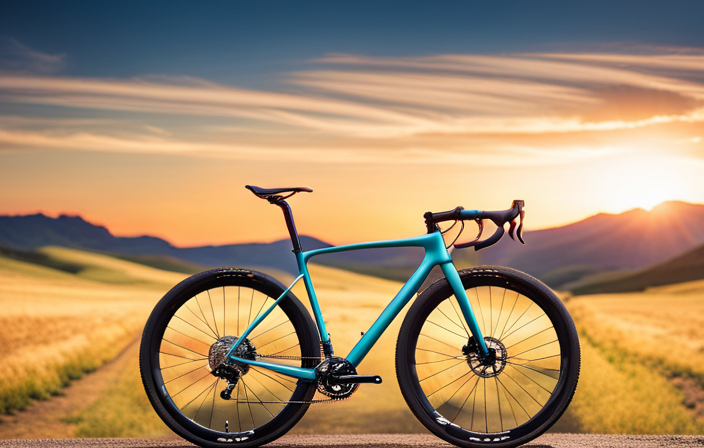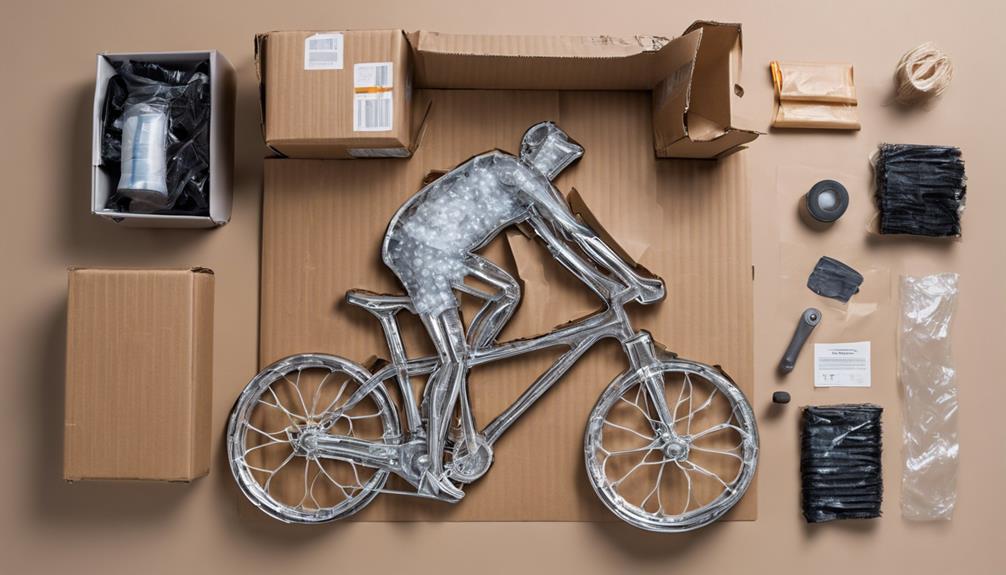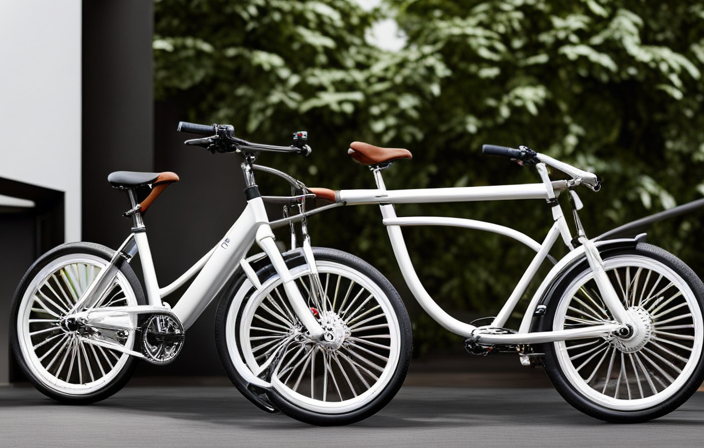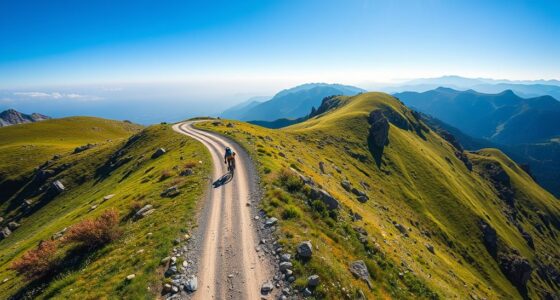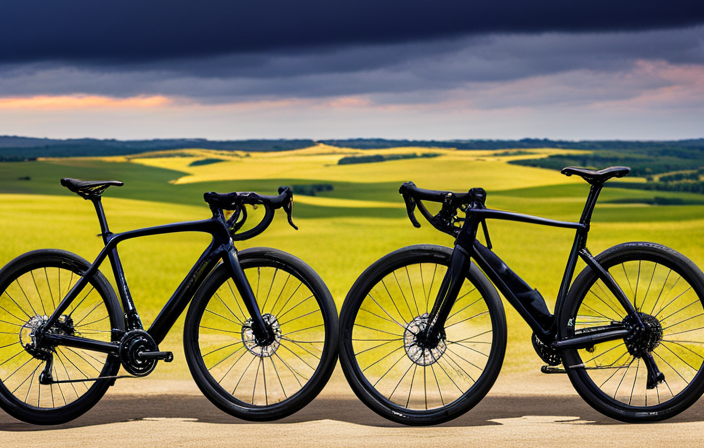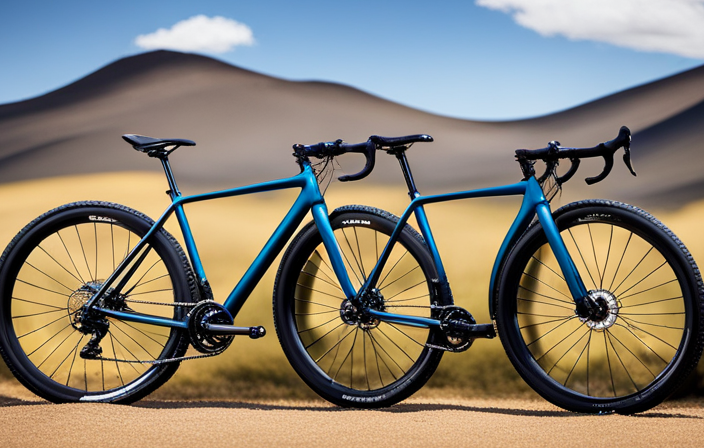Within the expansive universe of biking, there exists a call to both adventurers and explorers – the gravel bike. Resembling a reliable horse charging through wild, uncontrolled landscapes, this adaptable bike is engineered to effortlessly tackle rugged landscapes.
But before you embark on your gravel-grinding escapades, it’s crucial to choose the right bike for your needs. In this article, I’ll guide you through the process of picking a gravel bike, covering everything from riding style and budget to frame material and accessories.
So saddle up and let’s find your perfect companion for off-road adventures!
Key Takeaways
- Determine your riding style, terrain, and set a budget.
- Consider factors such as frame material, bike fit, components, and accessories.
- Choose the appropriate tire size, tread pattern, and understand the impact of tire pressure and tread on performance.
- Decide between disc brakes and rim brakes, considering factors such as stopping power, modulation, maintenance, and weight.
Determine Your Riding Style and Terrain
You’ll want to consider your riding style and the type of terrain you’ll be tackling when choosing a gravel bike. The first thing to think about is how you plan on using the bike. Are you an avid racer looking for speed and agility, or are you more interested in leisurely rides through scenic countryside? Different riding styles call for different features in a gravel bike.
If you’re into racing or fast-paced riding, it’s important to prioritize a lightweight frame and components. A bike that offers quick acceleration and responsive handling will give you the edge on those competitive group rides. On the other hand, if you prefer a more relaxed riding experience, look for a gravel bike with a more upright geometry that provides comfort during long hours in the saddle.
The type of terrain you’ll be traversing also plays a crucial role in choosing the right gravel bike. If your routes consist mainly of smooth dirt paths or well-maintained gravel roads, a bike with narrower tires and less aggressive tread patterns will suffice. However, if your adventures take you off-road onto rocky trails or loose surfaces, opt for wider tires with more grip.
Considering all these factors will help ensure that your gravel bike fits your specific needs and preferences. Now that we’ve covered how to determine your riding style and terrain requirements, let’s move on to setting a budget for your new ride without compromising quality.
Set a Budget
When it comes to setting a budget for a gravel bike, I always start by determining how much I’m willing to spend. This helps me narrow down my options and find the best bike within my price range.
To make an informed decision, I also research different price ranges and their corresponding features. This ensures that I get the most value for my money. Whether it’s comparing components, frame materials, or overall build quality, understanding the relationship between price and performance is key in finding the perfect gravel bike.
Determine how much you are willing to spend on a gravel bike
Decide how much you’re willing to spend on a gravel bike. When determining your budget, it’s important to consider the bike brands and whether you’ll be purchasing online or at a local store.
Different brands offer various price ranges, so it’s crucial to research and compare options before making a decision. Online purchasing can often provide more affordable options due to lower overhead costs for retailers. However, keep in mind that buying from a local store allows you to test ride the bike and receive personalized advice from experts.
Once you’ve set your budget, the next step is to research different price ranges and their corresponding features. This will help you understand what you can expect within your budget and make an informed choice when selecting your gravel bike.
Research different price ranges and their corresponding features
Take into consideration the different price ranges available and the corresponding features you can expect.
When researching gravel bikes, it’s important to explore various price points to find the best fit for your budget and needs. Different bike brands offer a range of options, each with their own set of features and specifications. Reading customer reviews can provide valuable insights into the performance and durability of different models.
Here are some factors to consider:
-
Entry-level bikes: Affordable options with basic components suitable for beginners or occasional riders.
-
Mid-range bikes: Offer better quality components and more advanced features for intermediate riders.
-
High-end bikes: Top-tier models with premium components, lightweight frames, and advanced technology.
-
Custom-built bikes: Tailored to your specific preferences but generally come at a higher cost.
Understanding the different price ranges will help you make an informed decision when selecting a gravel bike.
Moving on to frame material…
Frame Material
When it comes to choosing a gravel bike, one of the most important considerations is the frame material. There are several options available, including aluminum, carbon, and steel.
Each material has its own set of pros and cons that should be carefully considered. Factors such as durability, weight, and ride quality play a significant role in determining which frame material is best for your needs.
Compare the pros and cons of different frame materials (e.g., aluminum, carbon, steel)
One factor to consider when choosing a gravel bike is the pros and cons of various frame materials. Some common frame materials include aluminum, carbon, and steel.
When comparing frame materials like aluminum and titanium, there are a few key differences to keep in mind. Aluminum frames are lightweight and affordable, making them a popular choice for many riders. However, they can be less comfortable than other materials due to their stiffness.
Titanium frames, on the other hand, offer excellent durability and ride quality but come at a higher price point.
Moving on to carbon versus steel, carbon frames are known for their lightness and stiffness, providing exceptional performance on rough terrain. They are often favored by competitive riders.
On the other hand, steel frames offer superior strength and comfort but can be heavier. They are well-suited for riders who prioritize durability and a smooth ride.
When deciding which frame material suits your needs best, it’s important to consider factors such as durability, weight, and ride quality. By doing so, you can make an informed decision that doesn’t compromise any important features in your gravel bike choice.
Consider factors such as durability, weight, and ride quality
Consider factors like durability, weight, and ride quality as you decide on the frame material that best suits your needs. When it comes to gravel bikes, the frame material plays a crucial role in determining its overall performance.
Aluminum frames are popular due to their affordability and lightness, making them great for riders on a budget or those who prioritize speed. Carbon frames, on the other hand, offer superior vibration dampening and responsiveness, making them ideal for long-distance rides or rough terrain. Steel frames provide exceptional durability and strength but can be heavier compared to aluminum or carbon. Additionally, they offer a smoother ride feel due to their inherent flexibility.
As you weigh these options, also consider how different frame materials affect tire pressure. Stiffer materials like carbon may require higher tire pressures for optimal performance and efficiency. On the contrary, more flexible steel frames can benefit from lower tire pressures which enhance traction and comfort.
Considering all of these factors will help you make an informed decision about your bike frame before moving onto the next section about bike fit.
Bike Fit
When it comes to gravel biking, getting a professional bike fit is essential.
It ensures that your bike is adjusted to your body’s specific measurements and allows for optimal comfort and performance.
Investing in a proper bike fit will not only prevent discomfort and potential injuries but also enhance your overall riding experience on the gravel trails.
Get professionally fitted for a gravel bike
To ensure a proper fit for your gravel bike, you should definitely get professionally fitted. Bike fitting services offered by professionals have numerous benefits that can greatly enhance your riding experience.
These experts have the knowledge and experience to analyze your body’s biomechanics and make adjustments to optimize your position on the bike. They will consider factors such as saddle height, handlebar reach, and pedal stroke efficiency to ensure that you are in the most comfortable and efficient riding position possible.
Professional bike fitting can also help prevent injuries caused by poor alignment or improper positioning on the bike. By getting professionally fitted, you can ride with confidence knowing that your gravel bike is tailored specifically to your body’s needs. This will not only improve comfort but also enhance performance on all terrains.
Ensuring a proper bike fit for comfort and performance is crucial when it comes to enjoying your rides to the fullest extent while minimizing discomfort or potential injury risk.
Ensure proper bike fit for comfort and performance
Getting a professional bike fitting can greatly enhance your comfort and performance on all terrains. Proper bike fit is crucial for long rides and preventing injuries. During the fitting process, a trained specialist will assess your body measurements, flexibility, and riding style to determine the right bike size for you. They will make adjustments to the saddle height, handlebar reach, and pedal position to optimize your riding position. A well-fitted gravel bike ensures that your weight is distributed evenly between the saddle, handlebars, and pedals, reducing strain on your back and maximizing power transfer. It also allows for better control and maneuverability on rough terrains. Remember that an ill-fitting bike can lead to discomfort, pain, and decreased performance. So invest in a professional fitting before hitting the trails! Now let’s dive into the exciting world of components and gearing options for gravel bikes.
| Bike Sizing | Fitting Process |
|---|---|
| Take accurate body measurements | Assess flexibility |
| Determine frame size based on measurements | Analyze riding style |
| Adjust saddle height | Optimize handlebar reach |
| Fine-tune pedal position | Ensure even weight distribution |
Now let’s dive into the exciting world of components and gearing options for gravel bikes.
Components and Gearing
The gearing on a gravel bike is crucial for navigating various terrains. It determines how easily you can pedal uphill, maintain speed on flat surfaces, and tackle rough descents. When choosing a gravel bike, it’s important to consider the components and gearing that will best suit your riding style and the type of terrain you plan to ride on. Here are three key factors to keep in mind:
-
Gear Range: Look for a wide gear range that allows for both high-speed pedaling on flat sections and low gears for climbing steep hills. A wider range gives you more options to adjust your cadence according to the terrain.
-
Number of Gears: Gravel bikes typically come with either 1x (single chainring) or 2x (double chainring) setups. A 1x setup offers simplicity with fewer components and less chance of mechanical issues, while a 2x setup provides more gear options but may require more maintenance.
-
Brakes: Consider whether you prefer disc brakes or rim brakes. Disc brakes offer better stopping power and perform well in all weather conditions, but they can be heavier and require occasional maintenance.
With proper bike fit and brake maintenance in mind, let’s move on to the next section about tire clearance and width, which is another important aspect when selecting a gravel bike.
Tire Clearance and Width
Considering tire clearance and width is essential when choosing a gravel bike as it directly affects its performance on different terrains. The tire clearance refers to the amount of space between the frame and the tires, while the tire width refers to how wide the tires are. These two factors play a significant role in determining what type of terrain your gravel bike can handle.
When it comes to tire clearance, you’ll want to consider how much room there is for larger tires. Gravel bikes with greater tire clearance allow you to run wider tires, which can be beneficial for off-road riding. Wider tires provide more traction and stability, especially on loose or uneven surfaces. Additionally, they can absorb more shocks and bumps, improving overall comfort during long rides.
Tire width also plays a crucial role in determining your bike’s performance. Narrower tires are generally faster on smooth surfaces but may struggle on rougher terrains due to decreased traction and increased vulnerability to punctures. On the other hand, wider tires offer better grip and control in challenging conditions but might sacrifice some speed on smoother roads.
To optimize your gravel bike’s performance, it’s important to consider both tire pressure and tread pattern as well. Tire pressure affects how much traction you have while riding, so adjusting it based on the terrain can greatly improve your experience. Tread patterns vary depending on whether you prioritize grip or speed.
Considering all these factors will help you make an informed decision when choosing a gravel bike that suits your riding style and preferences.
Now let’s move onto discussing brake types in order to complete our comprehensive guide without skipping a beat.
Brake Type
When it comes to choosing a brake type for a gravel bike, there are two main options to consider: disc brakes and rim brakes.
Disc brakes offer superior stopping power and modulation, making them ideal for tackling steep descents or riding in wet conditions. They also require less maintenance compared to rim brakes, as they are not exposed to the elements and do not wear down the rims over time.
However, rim brakes can still be a viable option if you prioritize simplicity and weight savings.
Ultimately, the choice between disc brakes and rim brakes will depend on your specific riding needs and preferences.
Compare the different brake options (e.g., disc brakes, rim brakes)
To choose a gravel bike, it’s important to compare the various brake options available, such as disc brakes and rim brakes. When deciding between disc brakes vs. rim brakes, one must consider which is better for their specific needs. Disc brakes offer several advantages over rim brakes. They provide greater stopping power, especially in wet or muddy conditions, due to their ability to grip a rotor instead of a rim. Additionally, disc brakes offer more modulation, allowing for precise control over braking force. Maintenance is also easier with disc brakes as they are less affected by debris and wear on the wheel rims. Overall, disc brakes are the preferred choice for most gravel riders due to their superior performance and reliability. Moving forward into the subsequent section about considering factors such as stopping power, modulation, and maintenance…
Consider factors such as stopping power, modulation, and maintenance
You should take into account factors like stopping power, modulation, and maintenance when evaluating different brake options. When it comes to gravel biking, having reliable brakes is essential for your safety and control on varied terrain. Here are five important factors to consider:
- Stopping Power: Disc brakes generally offer superior stopping power compared to rim brakes, especially in wet or muddy conditions.
- Modulation: Disc brakes provide more precise control over braking force, allowing you to effectively navigate technical descents.
- Maintenance: Rim brakes are simpler to maintain and require less frequent adjustments than disc brakes.
- Bike Fit: Different brake systems can affect the overall fit of the bike, so it’s crucial to ensure that your chosen system works well with your body position.
- Bike Weight: Disc brakes add weight to the bike, which may impact your overall riding experience.
Considering these factors will help you make an informed decision about the best brake option for your gravel bike.
Moving on from braking performance, let’s now explore the importance of suspension.
Suspension
The suspension on a gravel bike is an important component that helps absorb bumps and vibrations for a smoother ride. When considering the suspension setup, it is crucial to find the right balance between comfort and efficiency.
Gravel bikes typically come with front suspension forks, which can be adjusted based on personal preferences and riding conditions. It’s essential to set up the suspension according to your weight, riding style, and terrain you’ll be tackling.
Regular maintenance of the suspension is also vital to ensure optimal performance. This involves checking for any signs of damage or wear, cleaning and lubricating the moving parts regularly, and keeping an eye on air pressure or spring tension. Suspension maintenance may require some technical knowledge or assistance from a professional mechanic if you’re not familiar with it.
As you transition into considering bike weight in relation to picking a gravel bike, it’s worth noting that while a lighter bike may offer better acceleration and climbing abilities, it might compromise some of the smoothness provided by the suspension system. Therefore, finding the right balance between suspension performance and overall bike weight is crucial for an enjoyable gravel riding experience.
Bike Weight
When evaluating different models of gravel bikes, one important factor to consider is their weight. The weight of a bike can significantly affect its performance on various terrains.
A lighter bike will generally allow for faster acceleration and easier maneuverability, while a heavier bike may provide more stability and durability.
Additionally, the weight of a bike also impacts its portability, especially when it comes to carrying or transporting the bike for travel or storage purposes.
Evaluate the weight of different gravel bike models
Start by checking out the weight of various gravel bike models. When evaluating different gravel bikes, it is crucial to consider their weight as it directly affects their performance on different terrains. A lighter bike will be easier to maneuver and accelerate, allowing you to maintain speed effortlessly. Additionally, a lighter bike can make climbing hills less challenging and more enjoyable. On the other hand, a heavier bike may provide more stability and durability but could feel sluggish and slow in comparison.
To evaluate the weight of different gravel bike models, pay attention to the frame material, components used, and overall design. Carbon fiber frames tend to be lighter than aluminum or steel frames but are often pricier. Similarly, higher-end components like carbon wheels or groupsets can contribute to reducing the overall weight.
Considering how weight affects performance and portability is essential when selecting a gravel bike that aligns with your riding preferences and goals.
Consider how weight affects performance and portability
Considering the weight of different models is crucial for evaluating their impact on performance and portability. When it comes to gravel bikes, weight plays a significant role in determining how well the bike performs on various terrains.
A lighter bike will be more responsive and easier to maneuver, especially when climbing hills or navigating through technical sections. On the other hand, a heavier bike may provide better stability and control at higher speeds.
Additionally, weight affects portability, as a lighter bike can be more easily transported or carried when needed. It’s important to find the right balance between weight, performance, and portability that aligns with your specific riding preferences and needs.
To further assess these factors, conducting test rides and researching different models will provide valuable insights into finding the perfect gravel bike for you.
Test Ride and Research
To pick a gravel bike, it is important to take it for a test ride and do your research. This step is crucial in ensuring that the bike fits your needs and preferences. Here are four key benefits of test riding and the importance of research:
-
Get a feel for the bike: Test riding allows you to experience how the bike handles different terrains, such as gravel roads or trails. You can assess its stability, responsiveness, and overall comfort.
-
Evaluate fit and geometry: Every rider has unique body proportions, so it’s essential to find a bike that suits your body type. Test riding helps determine if the frame size and geometry provide an optimal riding position.
-
Assess component compatibility: By test riding various models, you can compare components like gears, brakes, and tires to see which ones perform well for your intended use.
-
Confirm durability and quality: Researching brands and models beforehand will give you an idea of their reputation for reliability and build quality.
By taking these steps before making a purchase decision, you’ll be more informed about what to expect from different bikes on the market today.
Transitioning into brand reputation and warranty considerations, it’s important to consider these factors when researching potential options.
Brand Reputation and Warranty
When researching potential options, it’s important to consider the reputation of different brands and the warranty they offer. Brand reputation plays a crucial role in determining the overall quality and reliability of a gravel bike. Reputable brands have established themselves over time by consistently producing bikes that meet or exceed customer expectations. They have a track record of using high-quality materials, employing skilled craftsmanship, and incorporating innovative technology into their designs.
In addition to brand reputation, the warranty offered by a manufacturer is another key factor to consider. A good warranty provides peace of mind, as it ensures that any manufacturing defects or issues will be addressed promptly and efficiently. When evaluating warranties, it’s important to read the fine print and understand what is covered and for how long. Some brands offer lifetime warranties on certain components or frames, while others may only cover specific parts for a limited period.
To make an informed decision about which gravel bike to choose, it’s recommended to research brand reputations and compare warranty offerings among different manufacturers. This will help ensure that you invest in a bike from a reputable brand with a solid warranty that suits your needs.
Transitioning into the next section about accessories and customization options: Now that we’ve covered the importance of brand reputation and warranty considerations, let’s explore some exciting accessories and customization options available for gravel bikes.
Accessories and Customization Options
When it comes to choosing a gravel bike, one important factor to consider is the availability of accessory mounts. Look for models that offer mounts for racks, fenders, and bottle cages, as these can greatly enhance your riding experience by allowing you to carry gear and stay protected from mud and water.
Additionally, customization options are worth considering if you want to personalize your bike to your specific preferences. Whether it’s choosing a different color scheme or adding unique components, customizing your gravel bike can make it truly yours.
Look for gravel bike models that offer accessory mounts for racks, fenders, and bottle cages
Gravel bike models with accessory mounts for racks, fenders, and bottle cages offer great customization options and enhanced performance. Here are four reasons why these features are important:
-
Accessory options for gravel bike customization: Having mounts allows you to add accessories like racks and fenders. These additions can improve your biking experience by providing storage space for long rides or protecting you from mud and water splashes.
-
Importance of proper bike fit for comfort: With accessory mounts, you can easily adjust the position of your bottle cage or rack. This ensures a comfortable riding position, which is crucial for avoiding discomfort and potential injuries over time.
-
Importance of proper bike fit for performance: Properly fitted accessories such as racks contribute to better weight distribution on the bike. This improves handling and overall performance, allowing you to ride with more control and confidence.
-
Convenient hydration access: Bottle cages mounted on your gravel bike provide easy access to hydration during long rides. This ensures you stay hydrated without interrupting your flow, allowing you to maintain optimal performance.
Considering these factors when choosing a gravel bike with accessory mounts will help personalize your ride according to your preferences. In the next section, let’s explore customization options to further personalize your bike for optimal enjoyment.
Consider customization options to personalize your bike to your preferences
To personalize your ride to your preferences, you can explore various customization options for your bike. Customization allows you to add or modify components according to your specific needs and style. There are several aspects of the bike that can be customized, including the frame material, drivetrain, wheels, tires, and handlebars. By choosing the right combination of these elements, you can create a gravel bike that suits your riding style and terrain preferences.
To give you an idea of the customization possibilities, here is a table showcasing some popular options:
| Customization Options | Description |
|---|---|
| Frame Material | Choose between steel, aluminum, carbon fiber for different levels of comfort and weight |
| Drivetrain | Opt for a 1x or 2x setup based on your preference for simplicity or wider gear range |
| Wheels | Select wheel size (700c or 650b) and consider tubeless compatibility for enhanced performance |
| Tires | Customize tire width and tread pattern based on the type of terrain you plan to ride on |
| Handlebars | Decide between drop bars or flat bars depending on your riding position and control requirements |
By considering these customization options and tailoring them to suit your personalized preferences, you can create a gravel bike that is perfect for your needs. Now let’s delve into maintenance and serviceability considerations…
Maintenance and Serviceability
One important factor to consider when picking a gravel bike is the bike’s maintenance and serviceability. Proper bike maintenance is crucial in keeping your bike running smoothly and avoiding common service issues. Regularly cleaning your bike, lubricating the chain, and checking tire pressure are simple tasks that can greatly extend the lifespan of your components. It is also important to inspect your brakes, gears, and cables regularly to ensure they are functioning properly.
When it comes to serviceability, it’s a good idea to choose a gravel bike that has easily replaceable parts. This will make any necessary repairs or upgrades much simpler down the line. Look for bikes with standard sizes for things like bottom brackets, headsets, and axles, as this will make finding replacement parts easier.
Additionally, consider the availability of local bike shops that can provide maintenance services for your chosen gravel bike. Having experts who are familiar with your specific model can be extremely helpful when it comes time for more complex repairs or adjustments.
Considering these factors related to maintenance and serviceability will help you choose a gravel bike that is not only enjoyable to ride but also easy to maintain and repair in the long run.
In my next section about ‘consider future upgrades,’ I will discuss how selecting a versatile frame can allow you room for growth as you explore different riding styles.
Consider Future Upgrades
When considering a gravel bike, it’s important to think about any future upgrades or modifications you may want to make. Personally, I like the versatility of being able to upgrade components or add accessories as my riding preferences evolve.
Therefore, I would recommend choosing a gravel bike that allows for easy upgrades and modifications, ensuring that you can customize it to fit your specific needs and preferences in the future.
Determine if you plan to upgrade components or add accessories in the future
Consider whether you’ll want to upgrade components or add accessories down the line. When it comes to upgrading components, think about when and why you might want to do so. Upgrading certain parts like the drivetrain or brakes can improve performance and provide a more tailored riding experience. Adding accessories is also something to consider, as they can enhance your overall gravel biking experience.
Here are some factors to keep in mind:
- Compatibility: Check if the bike frame and components are compatible with potential upgrades.
- Budget: Determine how much you’re willing to invest in future upgrades or accessories.
- Future needs: Consider any specific features or functionalities that may be important for future upgrades.
- Resale value: Some bikes hold their resale value better than others, which could be beneficial if you plan on upgrading in the future.
- Ease of installation: Look for a bike that allows for easy upgrades and modifications.
With these considerations in mind, let’s move on to choosing a gravel bike that allows for easy upgrades and modifications.
Choose a gravel bike that allows for easy upgrades and modifications
To ensure a seamless experience in the future, make sure to select a gravel bike that offers effortless upgrades and modifications. Look for easy upgrade options, such as a frame with ample clearance for wider tires or compatibility with different wheel sizes. This will allow you to adapt your bike to changing terrain or riding preferences without hassle.
Additionally, consider the availability of compatible aftermarket parts. A bike with standard components will give you more options when it comes to upgrading or replacing parts down the line. Keep in mind that not all bikes are created equal in terms of upgradeability, so do some research before making a decision.
By choosing a gravel bike that allows for easy upgrades and modifications, you’ll have the flexibility to tailor your ride to your evolving needs.
When considering where to purchase your bike from, it’s important to buy from a reputable bike shop that can provide support and guidance throughout the upgrade process.
Purchase from a Reputable Bike Shop
When it comes to purchasing a gravel bike, one of the most important steps is finding a reputable bike shop.
I cannot stress enough the importance of seeking out a local shop with knowledgeable staff and excellent customer service.
These individuals will not only be able to guide you through the process but will also offer advice and support when making your final decision.
Find a local bike shop with knowledgeable staff and good customer service
Look for a local bike shop where you can find knowledgeable staff and excellent customer service to help you choose your gravel bike. Not only will these experts have the expertise to guide you, but they will also be able to recommend specific brands and models that are popular among the local cycling community.
Here are some key reasons why finding a reputable bike shop is crucial:
-
Personalized Recommendations: The staff at a good bike shop will take the time to understand your riding preferences and goals, ensuring they recommend the most suitable gravel bikes for you.
-
Test Rides: A reputable store will allow you to test ride different gravel bikes, helping you get a feel for their performance and comfort.
-
Local Cycling Community Involvement: These shops often organize group rides or events, giving you an opportunity to connect with other cyclists in your area.
-
Post-Purchase Support: Reputable shops provide excellent customer service even after your purchase, offering tune-ups, maintenance advice, and warranty support.
By seeking advice and support from professionals when making your final decision at the bike shop, you’ll gain invaluable insights into choosing the perfect gravel bike for your needs without feeling overwhelmed by the process.
Seek advice and support from professionals when making your final decision
When it comes to picking a gravel bike, finding a local bike shop with knowledgeable staff and good customer service is essential. They can guide you through the process of choosing the right bike based on your needs and preferences.
However, even with their expertise, seeking advice and support from professionals is still crucial when making your final decision.
By seeking expert advice and support from professionals in the cycling industry, you can gain valuable insights into different gravel bikes available on the market. These professionals have extensive knowledge about various brands, models, and components that make up a great gravel bike. They can help you understand the nuances between different options and steer you towards the best choice for your specific requirements.
Furthermore, professionals can provide guidance on factors like frame materials, tire sizes, gear ratios, and suspension systems. Their expertise will ensure that you make an informed decision based on your riding style and intended use of the bike.
In summary, while local bike shops are invaluable resources when selecting a gravel bike, seeking expert advice from professionals in the field will further enhance your decision-making process.
Frequently Asked Questions
How do I properly clean and maintain my gravel bike?
To properly clean and maintain my gravel bike, I start by gathering essential maintenance tools like a chain cleaner, brush, degreaser, and lubricant.
First, I remove any excess dirt or mud with a damp cloth.
Then, I use the chain cleaner and degreaser to remove grime from the drivetrain.
Next, I clean the frame and components with a brush and soapy water.
Finally, I apply lubricant to the chain and other moving parts for smooth operation.
What are some common issues that may arise with a gravel bike and how can they be resolved?
Common issues with gravel bikes can include chain drop, flat tires, and brake squeal.
To resolve chain drop, I recommend adjusting the front derailleur for proper alignment or installing a chain guide.
For flat tires, always carry a repair kit and learn how to patch or replace tubes.
Brake squeal can be fixed by cleaning the brake pads and rotors or replacing them if necessary.
Regular maintenance and inspections will help prevent these problems from occurring.
Are there any specific tools or equipment I need to have for gravel bike maintenance?
Are you wondering what tools and equipment you need for gravel bike maintenance? Well, let me enlighten you.
When it comes to keeping your gravel bike in top shape, there are a few essential tools you should have on hand. These include a set of metric Allen wrenches, tire levers, a chain tool, a torque wrench, and a good quality bike pump.
With these tools in your arsenal, you’ll be well-equipped to handle any maintenance tasks that come your way.
How often should I get my gravel bike serviced?
I recommend following a gravel bike maintenance checklist to ensure your bike is always in top condition.
As for servicing, it’s best to have your gravel bike serviced at least once a year or every 1,000 miles, whichever comes first.
However, pay attention to signs that your bike needs servicing such as unusual noises, difficulty shifting gears, or worn-out brake pads.
Regular maintenance will keep your gravel bike performing at its best and prolong its lifespan.
Can I upgrade certain components of my gravel bike in the future if I decide to?
Yes, you can definitely upgrade certain components of your gravel bike in the future if you decide to.
However, it’s important to consider compatibility issues when making upgrades.
Different bikes have different specifications and standards, so it’s crucial to ensure that any new components you choose are compatible with your bike’s frame, drivetrain, and other existing parts.
Consulting with a knowledgeable bike shop or doing thorough research beforehand can help you make informed decisions about component upgrades.
Conclusion
In conclusion, picking the right gravel bike requires careful consideration of several factors. Firstly, you need to think about your riding style and the type of terrain you will be riding on. Secondly, it’s important to set a budget for your bike purchase. Next, you should choose the appropriate frame material that suits your needs. Additionally, ensuring proper bike fit is crucial for comfort and performance. Another important aspect is selecting components and gearing that are suitable for your riding preferences. Furthermore, considering accessories and customization options can enhance your cycling experience. Moreover, prioritizing maintenance and serviceability is essential for the longevity of your bike. Lastly, leaving room for future upgrades is a good idea to keep up with your evolving needs.
Remember that purchasing from a reputable bike shop is essential to receive expert advice and guidance throughout the process. For example, let’s say you enjoy long rides on rough terrains with steep hills. A gravel bike with a lightweight carbon frame, wide range of gears for climbing, and tubeless tires for added traction would be an excellent choice to enhance your cycling experience.
